If you’ve ever gone to exhibits and wanted to purchase the art in a small, portable form, The Capital Art Book Fair has got you covered. From April 1–2, nearly 40 artists and independent presses gathered in the North Hall of Eastern Market to find art books to peruse at their pleasure.
Getting out of our Uber and walking through the Capitol Hill area was a pleasant experience, as Eastern Market in the warm weather often is. The sun shined brightly as families milled about, chatting about the beauty of D.C. in spring. One could sense the warmth of the neighborhood in the air, almost ensuring a delightful stroll through the art fair. Walking through the arch of North Hall, we entered the space which housed the Capital Art Book Fair. With ornate paper cherry blossoms adorning the ceiling, and sheer volume of artists and their works, the fair added something more energetic to the often-predictable Eastern Market.
Phil Hutinet, the fair’s organizer and founding publisher of East City Art, wanted to create a space where local artists could promote and sell their work, which has been rather difficult to do during the pandemic; some even sold what had been created in 2019.
Hutinet began planning this event in the fall of 2021, after being exposed to the art book format in social media. Curious, he traveled across the country to visit numerous art book fairs in places like LA, NYC and the greater New England area. “It varies from everything from super DIY to very organized; I saw there was a lot of possibility. As a small publisher, this [idea] dovetails really well with what we do anyways.” Hutinet became interested in doing one here in D.C., resulting in the birth of the Capital Art Book Fair.
When deciding where to host the fair, Hutinet drew inspiration from his own community: Capitol Hill. “It is like a small town in a big city. The neighborhood spirit and community is very, very strong over here,” Hutinet told the Voice. “So I knew that by putting this in the Eastern Market, there would be this massive show of support from the community in the neighborhood, so that even if nobody covered this event, the neighborhood would still come out in force, and they even had several exhibitors who were from the neighborhood.”
The Capital Art Book Fair was held in an incredible space, and when I was walking through, I could feel the community that existed there. The environment of the Eastern Market creates a welcoming space, one that is easy to wander in for hours. As you pass through the booths, you can see artists communicating with each other and their potential customers. They invite conversation about their work, eager to show off what they have spent their time on—most impressionable was their love for their work. The best part of my experience was simply talking to them about it.
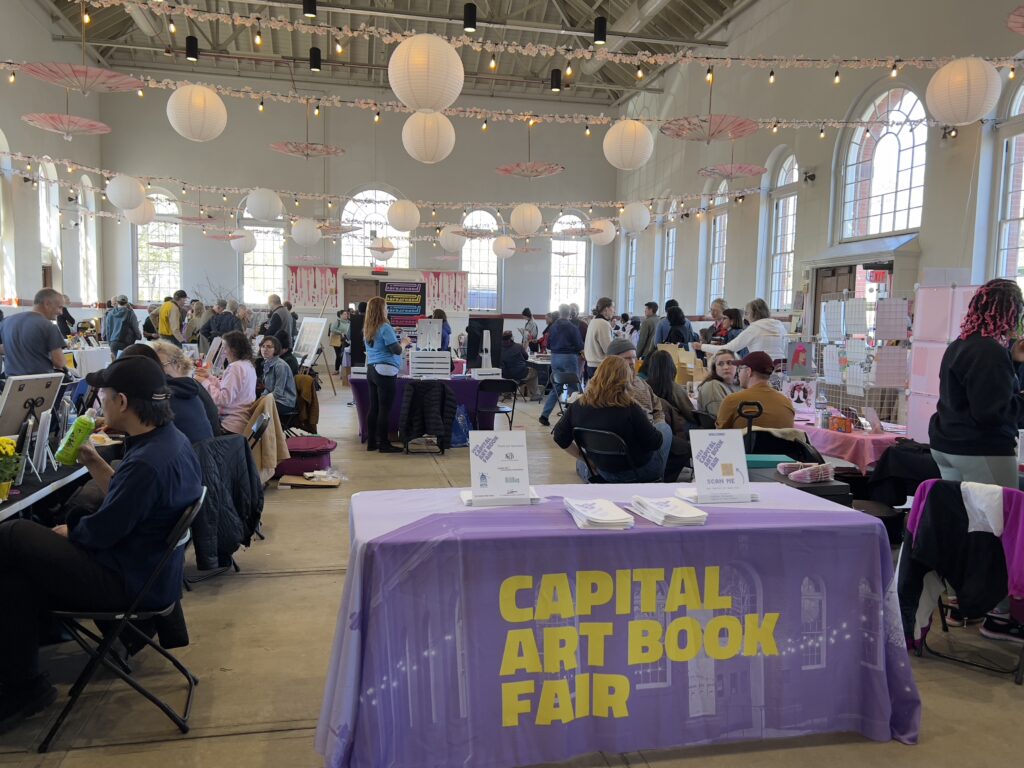
Eastern Market’s North Hall during the fair
Hutinet emphasized that Eastern Market is a staple of the community, and one of the oldest markets in the country, which helped make the market such a success. “Literally thousands of people go through there. One artist sold so much work that he had to go home and draw [more] on Saturday night [for the next day]. One of the artists whom I love, who’s a photographer, sold so many of her books.”
That artist was Carolyn Toye, a DC-based photographer that depicts the changes in local architecture over time, representing the district’s constant evolution. She met Hutinet in 2012 through the art show Emulsion, which he directed. Since then, Hutinet had been one of her biggest supporters, even writing a forward for her self-published book. She got involved in this fair through him, but really chose it due to her audience. “Washingtonians are very passionate about their city,” Toye said. Her primary audience is the residents of DC, with most of them recognizing the structures in her book.
Toye got into photography 20 years ago at her publishing job when a co-worker spoke about her own hobby, inspiring Toye to purchase first a film camera, and then later a digital one. “I was so interested in it that I was like, ‘I’m going to do whatever I can to fit photography into my life. And if I see something that I love or that I think is beautiful, then I’m going to photograph it,’” she said. “It just so happened that in doing all this, [especially by] driving through the city, I just started to fall in love with the architecture, and I would drive past something, and it just would speak to me.”
After a temporary pause due to her son applying for college, Toye returned to photography, picking up her camera again. “And that’s when I noticed that a lot of the buildings that I photographed were gone and that’s the beginning of the idea to memorialize them in a book.” Keeping a camera on her at all times, Toye documented the city through objects. Rather than people, Toye predominantly used architecture to show how D.C. changed so quickly and so often. Toye was often asked if she regretted the potential pictures she missed because she didn’t know a building was going to be gone, or because she didn’t have her camera on hand. However, it was quite the contrary: “I didn’t know that those buildings were going away… If I did, it would be a different body of work.”
Calling her work “urban fine art,” Toye explores the cityscape in its basic elements: color, texture, line, pattern. Her work resonates with the tumultuous change that comes with being in a city—a sentiment I can speak to, coming from a suburb, and adjusting to D.C.’s constant moving and changing. Toye’s photos, collected in the book The D.C. I See—Art of a Vanishing City, memorialize her vision of the city, the one that she loves. It can provide a memory for those who live here, and comfort for those who newly move here.
Another artist that participated in the fair was Christopher Kardambikis, an assistant professor at George Mason University. Kardambikis’ interest in zines—self-published works that are usually reproduced through copy machines—began in 2005. Starting with small presses in California, Kardambikis grew his passion in New York through Paper Cuts, his project that explores the artform. “It is a podcast that interviews other zinesters and book artists.” Featuring over 100 artists, Paper Cuts has grown over the years: “Paper Cuts has started organizing programs of local arts organizations like Transformer or with the Washington Project for the Arts as well as occasionally publishing work by other artists.”
Kardambikis came across the Capital Art Book Fair and was interested for two reasons: first, to see how it would exist in the Eastern Market; second, to meet other book artists and publishers. The fair lent him the opportunity to also meet new publishers and other people who just started doing book fairs.
“The big thing with the book fair is that sense of community, and for me, there’s always people around these events that I’ve known for a long time, like Jay Morrison who runs the project HOMOCATS,” Kardambikis said.
When asked which of his works he was most excited about, he responded with his most recent project: Chronomachy. It sold out on the second day of the fair, and is a retelling of the Greek myth of Chronos, a titan and the first ruler of the Greek gods. However, Kardambikis put his own spin on the centuries-old tale: “I paired that story with some ideas around the formation of black holes. As [one] moves through [the book], it posits that Chronos’ ultimate fate is that he becomes the super massive black hole at the center of the Milky Way.” A unique approach and combination, Kardambikis’ work demonstrates the novelty and intrigue zines can produce. His use of colorful graphics and striking fonts accentuate the story he is trying to tell. “The Cave of Nyx,” for example, combines the dark text with the gaping hole, mirroring the goddess of night and the black hole she represents. “I like to work with Greek mythology, or just mythology in general,” he said. “I enjoy astrophysics and celestial machines, so finding space in the book world to join these two narrative threads is something that I’m always interested in.”
Due to the fair’s success, Hutinet has already signed a contract for the Capital Art Book Fair next year on April 6th and 7th. Curious about the way it could expand, I asked Hutinet about the challenges that continuing this fair would present.
“[While] limited by the space of Eastern Market, we had 30-some vendors this year but can expand to 50. The biggest challenge next year is going to be how we can accommodate all the people who should be coming back next year and how to keep it fresh and interesting,” he said. Considering a policy where artists can exhibit every other year, there are numerous possibilities for the expansion of the fair. Mark your calendars for next April, as the fair will definitely be another hit.
This article was updated on May 2, 2023, at 2:00 pm to correct an error regarding Toye’s work.


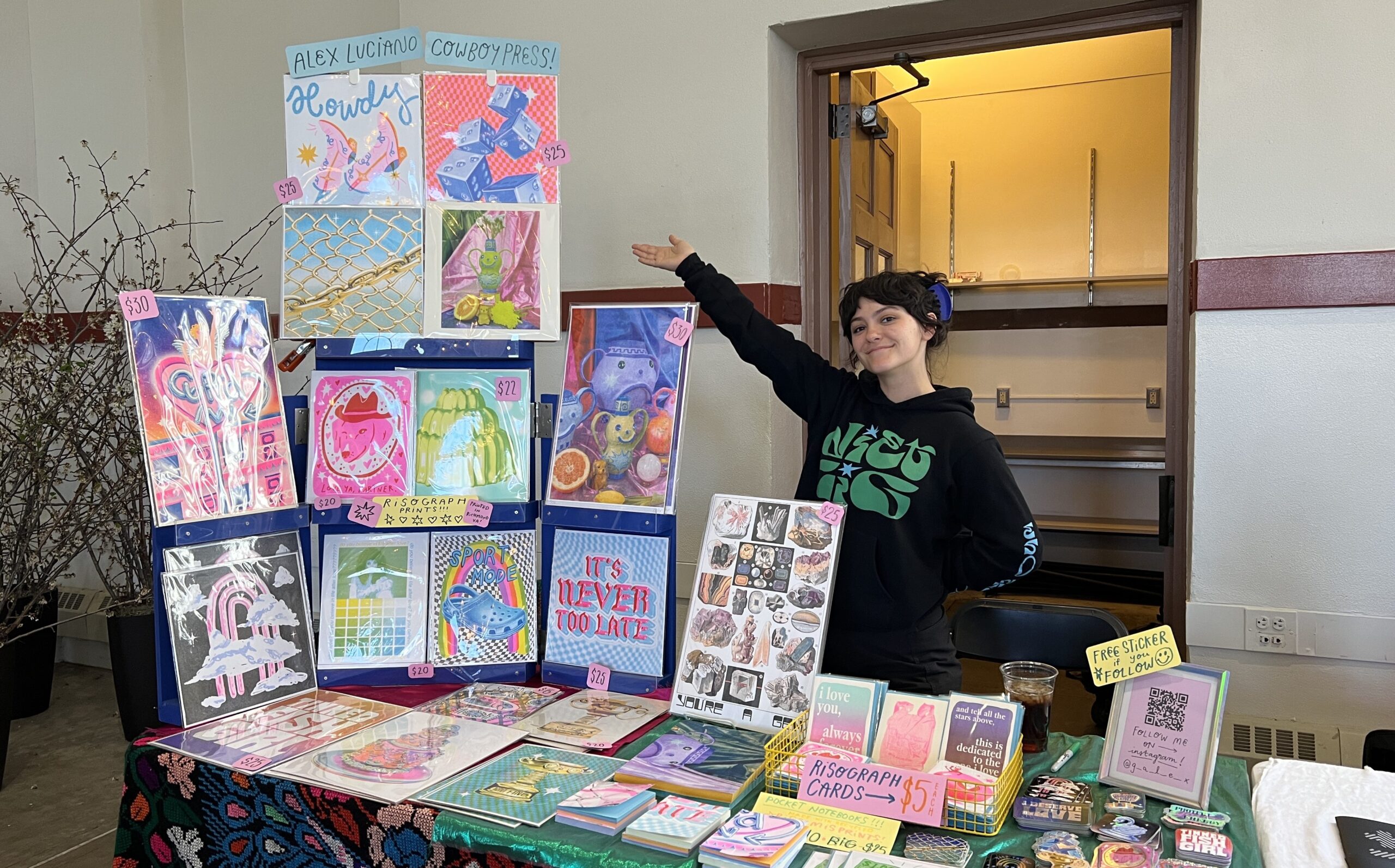
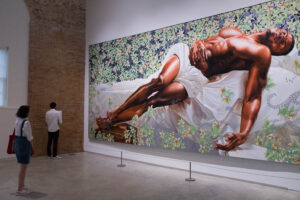
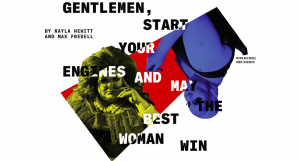
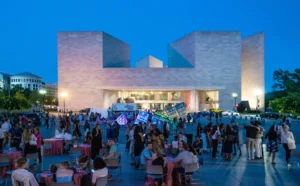
How wonderful to hear about The Capital Art Book Fair, connecting independent artists with the D.C. community! It sounds like a delightful event, and I truly appreciate the efforts to support local artists, especially during these challenging times. I, too, love to write, sometimes ask help from TrustMyPaper and understand the joy of sharing one’s creative work with others. The fair’s setting in Eastern Market sounds lovely, and I can imagine the warm atmosphere and the passion of the artists as they interact with visitors.